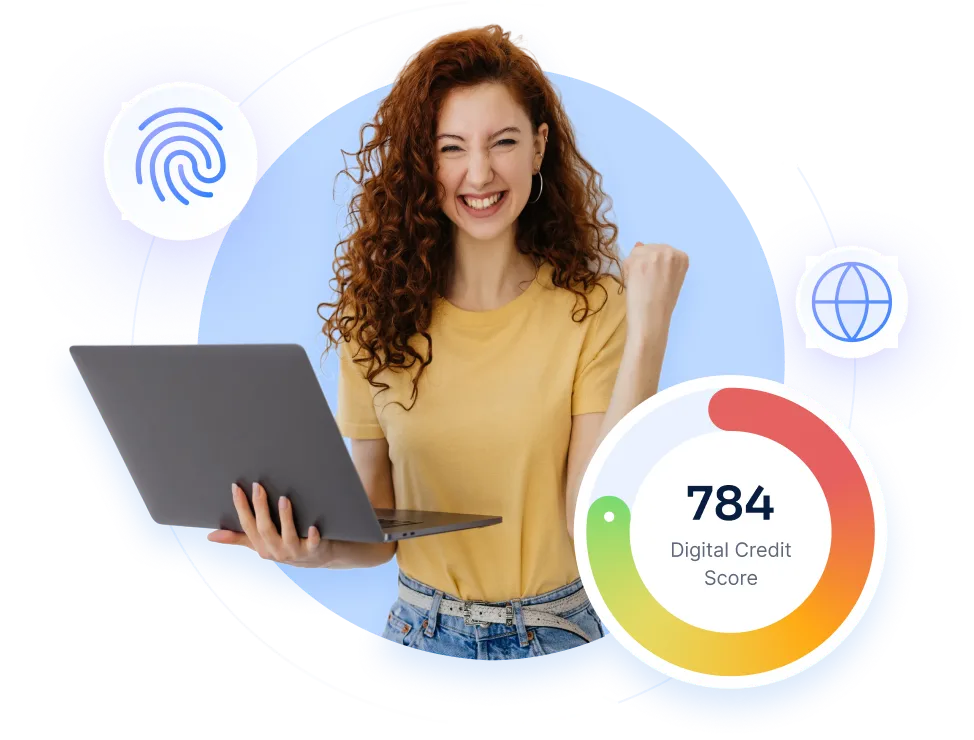Combating Emerging Fraud Schemes in P2P Lending Through Digital Footprint Analysis
Explore the most prevalent fraud schemes in P2P lending and the crucial role of digital footprint analysis.

The global P2P lending market is growing quickly and could reach USD 804.2 billion by 2030 with a CAGR of 29.1%, changing the way people borrow and invest.

With this growth comes the challenge of managing risks and preventing fraud. P2P lending platforms face a continuous battle against fraudsters who attempt to exploit the system.
In this article, we will look at the most popular fraud trends in P2P lending. It sheds light on the changing financial crime landscape. We'll also explore the essential role of a digital footprint in protecting P2P lending businesses from these threats.
Navigating the challenges of fraud in peer-to-peer lending
Peer-to-peer lending offers an alternative financing option. It provides benefits like lower interest rates and increased credit access.
The rise of fraud in P2P lending platforms poses a significant challenge. Fraudsters exploit the Internet's anonymity. This lets them secure loans without intending to repay.
The 2022 Federal Trade Commission report revealed a significant increase in scams within the P2P lending space.
Five most prevalent fraud schemes in the world of P2P lending
The dynamic world of P2P lending offers expanding opportunities for borrowers and investors. But it also brings challenges of fraud. Identity theft and other complex fraud methods harm individuals. They also increase costs for everyone involved.
Let's explore some common fraud types. We will also understand how they affect the P2P lending ecosystem.
#1. Identity theft and fake identities
Identity theft is a widespread issue in the financial world, and P2P lending is no exception. Fraudsters often create fake identities or steal legitimate ones. They use them to apply for loans with no intention of repayment. They leave victims with debt and cause significant financial losses for lenders.

#2. Synthetic identity fraud
This involves combining real and fake information to create new identities. They use these identities to apply for loans. These synthetic identities can be harder to detect. They can lead to large financial losses over time.

#3. Social engineering
Social engineering involves tricking individuals into divulging confidential information. Fraudsters then use this information to apply for fraudulent loans. This tactic often relies on psychological manipulation. It is a particularly insidious form of fraud.
#4. Bust-out fraud
Borrowers build good credit, then disappear after maxing out their loans. This method involves a series of small, punctual repayments to gain trust. Then, a sudden, large withdrawal of funds leads to significant losses.

#5. Loan stacking
Loan stacking is when a borrower takes out many loans from different lenders in a short time. Lenders may not have immediate visibility into other recent loans. This can lead to overextension of credit and increased default risk.
Each of these fraud types presents a challenge in the P2P lending industry. This requires a multifaceted approach to fraud detection and prevention. By understanding these schemes, P2P platforms can develop more effective strategies. This will help to protect both their customers and their own financial health.
The power of digital footprint analysis in mitigating P2P lending fraud
In the age of information, digital footprints are a critical navigational tool for P2P lending businesses. They need to foster trust, enhance security, and drive growth through data-driven lending strategies.
The P2P lending model continues to disrupt traditional financial paradigms. Understanding and leveraging the digital traces that users leave behind is not helpful. It's essential.
Digital footprint analysis is a seamless and effective tool in the prevention of loan fraud. This method allows checking a person’s online presence. It creates a detailed identity picture that is difficult to fake or change.
A digital footprint includes a comprehensive record of an individual's online activities. It covers registered accounts on various platforms. It includes accessible social media data and even indicators like upvotes or downvotes on reviews.

This mosaic of online actions paints a vivid picture of users' behavior and history. It offers invaluable insights for P2P lending platforms. As the industry grows, fraudsters become more sophisticated. They use clever methods to bypass traditional risk assessment measures.
In response to this escalating challenge, innovative solutions are crucial. They must use digital footprints to gain better customer insights. Also, they have to use digital footprints to strengthen fraud prevention strategies.
How to use digital footprint analysis for advanced customer verification
Digital footprinting stands out by offering real-time, scalable verification processes. These processes are especially crucial in underbanked regions. It evaluates the digital presence of loan applicants and assists lending businesses with fraud detection.
Here's how you can put it to use.

Email analysis
It involves deep analysis of social media profiles. Additionally, it involves domain verification to confirm the authenticity of an email address. This includes checks against blacklists, data breaches, and whether the email appears on various online platforms.
Phone analysis
This verifies the reality of the phone number. It also checks its engagement with messaging and social profiles and its longevity.
IP analysis
Determining the true origin of an online connection. Identifying the use of proxies or VPNs by someone and determining their location.
Connecting these footprints helps reveal various details, like ties to social media, VPN/Proxy use, how long phone numbers or emails have been around, and confirming communication authenticity.
This gives a thorough look at an applicant's online actions, showing potential issues and aiding smarter lending choices.
How RiskSeal can help with digital footprint analysis
At RiskSeal, we use advanced digital analysis to give useful information to lenders. Our real-time API checks for loan fraud by analyzing over 400 digital and social signals.
We help lenders make smart decisions, reducing the chance of fraud by providing valuable information.

Download Your Free Resource
Get a practical, easy-to-use reference packed with insights you can apply right away.

Download Your Free Resource
Get a practical, easy-to-use reference packed with insights you can apply right away.




FAQ
What is digital footprint analysis, and how does it apply to P2P lending?

Digital footprint analysis involves examining the online presence and activities of individuals. In the context of P2P lending, it means assessing a person's online behavior such as social media activity and transaction history. The aim is to evaluate their creditworthiness and reduce lending risks. This helps lenders make informed decisions about borrowers in the online lending environment.
What types of online behaviors and interactions does RiskSeal analyze to evaluate creditworthiness?

We analyze a range of online behaviors and interactions, including but not limited to social media activity, online purchases, and browsing patterns, to comprehensively assess creditworthiness and provide an understanding of the user's digital footprint.
How does RiskSeal's solution ensure customer privacy while conducting digital footprint analysis?

Our solution prioritizes customer privacy by strictly adhering to regulations and employing advanced encryption measures to safeguard all collected digital footprints, ensuring secure and confidential analysis.
Can RiskSeal’s digital footprint analysis be integrated with existing P2P lending platforms?

Yes. RiskSeal’s solution is offered in the form of an API that can easily be integrated into a data collection process in a P2P lending platform. These data points can further be used in creating customer scorecards and building rules around them.

.svg)

.webp)
.webp)


